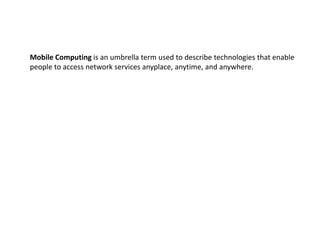
Mob ppt
- 1. Mobile Computing is an umbrella term used to describe technologies that enable people to access network services anyplace, anytime, and anywhere.
- 2. APPLICATIONS OF MOBILE COMPUTING • • Vehicles: Music, news, road conditions, weather reports, and other broadcast information are received via digital audio broadcasting (DAB) with 1.5 Mbit/s. For personal communication, a universal mobile telecommunications system (UMTS) phone might be available offering voice and data connectivity with 384 kbit/s. The current position of the car is determined via the global positioning system (GPS). Cars driving in the same area build a local ad-hoc network for the fast exchange of information • • Emergencies : An ambulance with a high-quality wireless connection to a hospital can carry vital information about injured persons to the hospital from the scene of the accident. All the necessary steps for this particular type of accident can be prepared and specialists can be consulted for an early diagnosis. • • Business: Managers can use mobile computers say, critical presentations to major customers. They can access the latest market share information. At a small recess, they can revise the presentation to take advantage of this information. They can communicate with the office about possible new offers and call meetings for discussing responds to the new proposals.
- 3. Credit Card Verification: At Point of Sale (POS) terminals in shops and supermarkets, when customers use credit cards for transactions, the intercommunication required between the bank central computer and the POS terminal, in order to effect verification of the card usage, can take place quickly and securely over cellular channels using a mobile computer unit. Replacement of Wired Networks: wireless networks can also be used to replace wired networks, e.g., remote sensors, for tradeshows, or in historic buildings. Due to economic reasons, it is often impossible to wire remote sensors for weather forecasts, earthquake detection, or to provide environmental information. Wireless connections. Infotainment: wireless networks can provide up-to-date information at any appropriate location. The travel guide might tell you something about the history of a building (knowing via GPS, contact to a local base station, or triangulation where you are) downloading information about a concert in the building at the same evening via a local wireless network. Another growing field of wireless network applications lies in entertainment and games to enable, e.g., ad-hoc gaming networks as soon as people meet to play together.
- 4. Limitations of Mobile Computing • Resource constraints: Battery • Interference: Radio transmission cannot be protected against interference using shielding and result in higher loss rates for transmitted data or higher bit error rate respectively • Bandwidth: Although they are continuously increasing, transmission rates are still very low for wireless devices compared to desktop systems. Researchers look for more efficient communication protocols with low overhead. • Dynamic changes in communication environment: variations in signal power within a region, thus link delays and connection losses • Network Issues: discovery of the connection-service to destination and connection Stability • Interoperability issues: the varying protocol standards • Security constraints: Not only can portable devices be stolen more easily, but the radio interface is also prone to the dangers of eavesdropping. Wireless access must always include encryption, authentication, and other security mechanisms that must be efficient and simple to use.
- 5. GSM Services The Services provided by GSM are categorized as 1. Teleservices Services 2. Supplementary Services 3. Bearer Services •
- 6. Teleservices · Telephonic voice at full data rata (13.4 kbps) · Fax, sms, emergency number · MMS · Teletext, Video text Teleservices are point to point i.e. from one equipment to another
- 7. Supplementary Services These services are enhancements to standard telephony service. These are specific to service provider. These supplementary services are • User Identification • Call forwarding • Closed user GPS formation • Multi party groupings • Call Waiting • Call holding • Call Barring for a user or gp of uses • Information regarding call charges etc.
- 8. Bearer Services Bearer: Set of data transmitted or received from terminal equipment. Bearer s ervices are responsible for transmission of data leading to explosion in use of mob ile internet access and mobile data transfer. Voice signals are also transmitted as data. Voice Data: Data obtained after digitizing, coding, encoding appending error detection and correction bits and encrypting of voice signal The Data rates for bearer services vary from service to service.
- 9. GSM Architecture GSM is a network with hierarchical structure with architecture consisting of basic 3 sub – systems namely: 1. Radio Sub System 2. Network Sub System 3. Operation Sub System